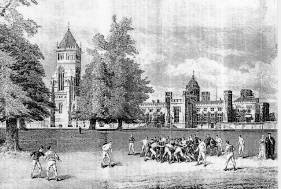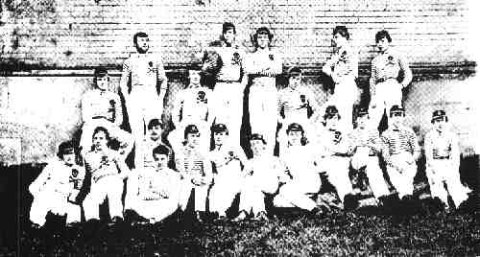橄榄球的历史

现在全世界都知道的橄榄球运动,其起源可以追溯到2000多年前。 罗马人玩的球类游戏叫作 harpastum、 这个词来自希腊语的 "抓住",这个名字的含义是有人实际携带或处理球。
See_also: 托马斯-贝克特最近,在中世纪的英格兰,文件记录了年轻人提前下班,为他们的村庄或城镇参加足球比赛。 在都铎时代,通过了法律,禁止" 魔鬼的消遣" 这场比赛的参赛者 魔鬼的消遣 有这样的记录...... "球员都是18-30岁或以上的年轻人;既有已婚的,也有单身的,还有许多对这项运动有兴趣的老兵,他们偶尔会在激烈的冲突中出现...... "有人会说,这样的描述在今天和多年前一样适用。
Shrove Tuesday成为这种冲突的传统时间。 全国各地的规则各不相同,从德比郡到多塞特,再到苏格兰,记录显示游戏有许多地区性的变化。 游戏经常在不明确的场地上进行--球被踢、被带、被赶,穿过城镇和村庄的街道,穿过田野、树篱和溪流。
现代橄榄球运动的根基可以追溯到一所学校,该学校是由美国人创办的。 年轻的先生们 拉格比学校的新址拥有"......为锻炼年轻绅士而可能需要的一切设施"。 这块八英亩的土地被称为 "关闭"。
1749年至1823年期间,足球比赛在近郊进行,规则很少:引入了边线,可以接球和处理球,但不允许持球跑动。 向对方球门前进通常是通过踢球实现的。 比赛可以持续五天,通常包括200多个男孩。 为了取乐,40名老年人可能会对两个百名低年级学生,高年级学生为这次活动做了准备,首先将他们的靴子送到镇上的鞋匠那里,换上了特别厚的鞋底,前面有斜面,以便更好地切入敌人的小腿!
 正是在1823年秋天在Close进行的一场比赛中,比赛的面貌发生了变化,变成了今天可以识别的样子。 一位当地的历史学家这样描述这一历史事件:"威廉-韦伯-埃利斯完全无视他那个时代的比赛规则,第一次把球抱在怀里并带着它跑,从而开创了橄榄球比赛的独特特征。" 埃利斯根据当时的规则,他应该向后移动,给自己留出足够的空间,把球踢到场上,或者把球踢到球门上。 他可以免受对方的保护,因为他们只能前进到接球的地方。 由于无视这一规则,埃利斯接住了球,而不是退场,而是这是一个危险的动作,直到1841年才被写入快速发展的规则书。
正是在1823年秋天在Close进行的一场比赛中,比赛的面貌发生了变化,变成了今天可以识别的样子。 一位当地的历史学家这样描述这一历史事件:"威廉-韦伯-埃利斯完全无视他那个时代的比赛规则,第一次把球抱在怀里并带着它跑,从而开创了橄榄球比赛的独特特征。" 埃利斯根据当时的规则,他应该向后移动,给自己留出足够的空间,把球踢到场上,或者把球踢到球门上。 他可以免受对方的保护,因为他们只能前进到接球的地方。 由于无视这一规则,埃利斯接住了球,而不是退场,而是这是一个危险的动作,直到1841年才被写入快速发展的规则书。
橄榄球的规则和名声随着橄榄球学校男孩们的不断进步而迅速传播,首先是牛津大学和剑桥大学。 第一场大学比赛是在1872年进行的。 从大学毕业的教师们将橄榄球介绍给其他英国、威尔士和苏格兰的学校,并为那些已经转入军队的老橄榄球人提供海外职位。1871年,苏格兰在爱丁堡的Raeburn Place与英格兰进行了第一场国际比赛。

上面的照片显示了 年轻的先生们 他们装备前面的骷髅头和十字骨徽章,也许证明了比赛的温和性质,球的形状是由内部使用的猪膀胱决定的。
在最近的现代比赛中,英格兰队在2003年成为第一支赢得橄榄球世界杯的北半球球队。 下面是胜利的英格兰队队长马丁-约翰逊在橄榄球的发源地--沃里克郡的橄榄球学校的近距离签名的照片。


